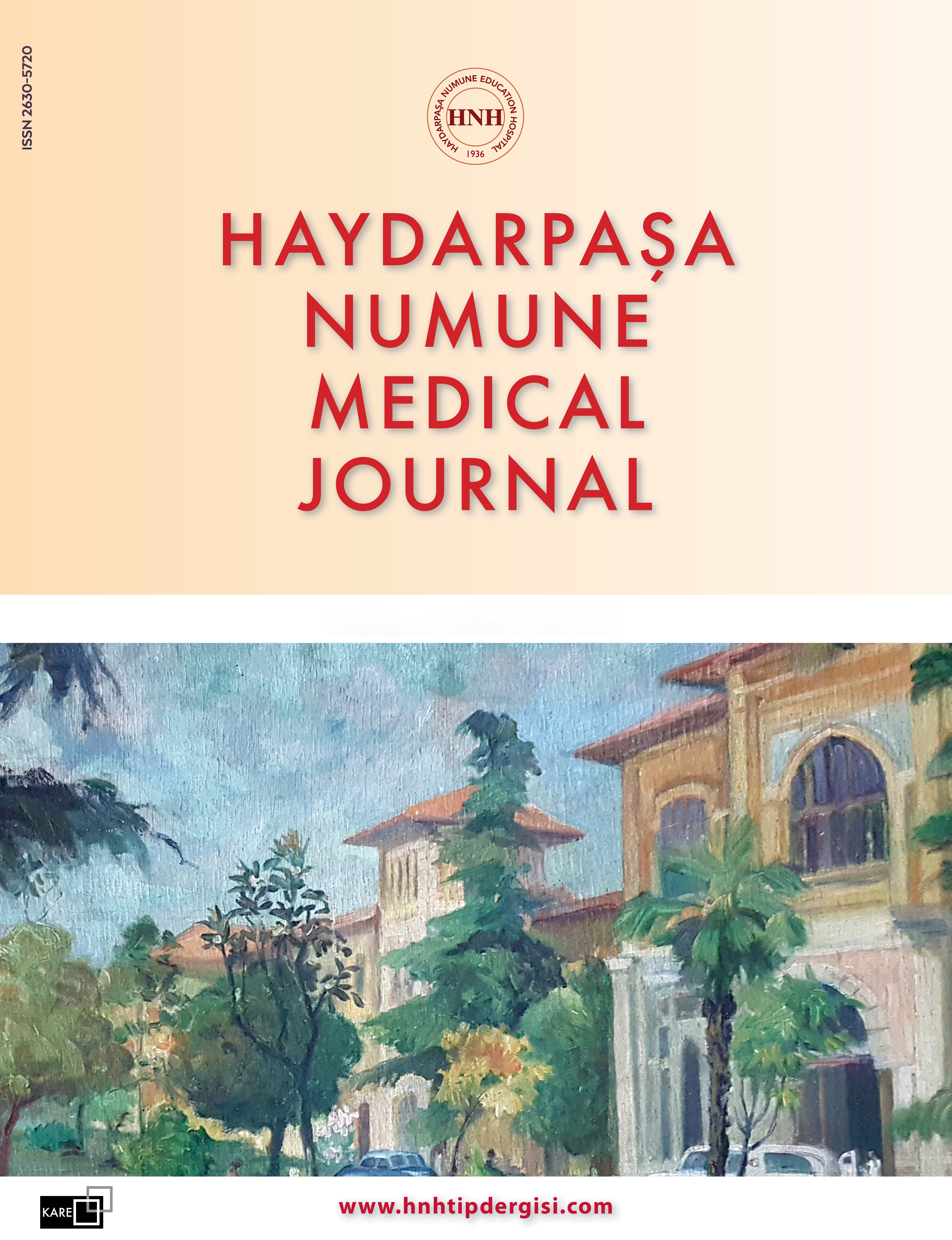Volume: 54 Issue: 2 - 2014
| RESEARCH ARTICLE | |
| 1. | Evaluation of Regional Anesthesia Complications Retrospectively Aydan Çalışkan, Volkan Hancı, Dilek Okyay, Serhan Yurtlu, Hilal Ayoğlu, M. Çağatay Büyükuysal, Işıl Özkoçak Turan Pages 73 - 86 INTRODUCTION: We retrospectively analyzed complications of patients operated under regional anesthesia from January 2009 to December 2010 years. METHODS: We reached information of 2000 patients in this period. Only 1568 patients complications were analyzed who had gone under successful regional anesthesia for various surgical operations. Complications were grouped as preoperative, perioperative and postoperative complications. RESULTS: In our study, it is found out that 585 of 1568 patients (37, 3 %) have had complications related to regional anesthesia. The most reported complication was hypotension with a rate of 16,8 % (n=264). Other complications were bradycardia 9,5 % (n=149), nausea and vomiting 15 % (n=235), dysrhythmia 0,5 % (n=8), cardiac arrest 0,2% (n=3), accidental dura puncture 1,1 % (n=17), hypertension 2,7 % (n=42), postdural puncture headache 0,2 % (n=3), excessive postoperative pain 1,1% (n=17), motor deficite 0,3% (n=5), sensorial deficite 0,1 % (n=2) and shivering 0,1% (n=1). The complication rate of in female patients were 49, 2 % (n=342) whereas male patients rate was 27, 8 % (n=243) (p<0,001). Bradycardia rate (n=103) was higher in men, and hypotension (n=189), vomiting (n=189) and excessive agitation (n=31) was reported mostly in women. The rates of patients who were not in need of therapy for complications were 0, 7 % in bradycardic and 0, 4 % in hypotensive patients. DISCUSSION AND CONCLUSION: In conclusion, the most reported complication was hypotension in all patients. |
| 2. | Clinical and Epidemiological Features of Insulin-dependent Diabetes Mellitus Patients Duygu Sömen Bayoğlu, Narin Akıcı, Veysel Bayoğlu, Tamay Gürbüz, Çağatay Nuhoğlu Pages 87 - 92 INTRODUCTION: In this study we aimed to evaluate clinical and epidemiological features of diagnosed with insulin - dependent diabetes patients, who were hospitalized in our service last 7 years. METHODS: In our clinic 41 diagnosis of type 1 diabetes cases between 2006 - 2013 were included in the study. Age, sex, application season and symptoms, clinical and laboratory findings, family histories of patients were recorded. According to the clinical presentation of patients at diagnosis were divided into 4 groups including hyperglycemia, ketosis, diabetic ketoacidosis and coma ketoacidosis. RESULTS: Type 1 diabetes when analyzed according to age groups with the highest rate of 65% were found in the age range 10-15. The most frequent application of season was winter, the most frequent application of symptoms polyuria, polydipsia, and nausea vomiting were found. The average of duration of symptoms was 11.3 days before patients application. HBA1C measurements could look in 32 cases, and the average was 12.32. When the group of patients classified according to 61% ketoacidosis, 34.1% ketosis, 2.4% ketoacidosis coma and 2.4% hyperglycemia group. DISCUSSION AND CONCLUSION: The incidence of type 1 diabetes in children is increasing all over the world. Our study also found a higher rate of 61% of diabetic ketoacidosis; still the most important in type 1 diabetes is a leading cause of morbidity and mortality. Our society should create awareness about type 1 diabetes and thus should be targeted to reduce diabetic ketoacidosis. |
| 3. | Correlation Between Diagnosis Tests and Ocular Surface Disease Index (OSDI) in Dry Eye Disease Hatice Tekcan, Ayşe Burcu, Firdevs Örnek Pages 93 - 98 INTRODUCTION: To evaluate correlation between diagnosis test results, delphi panel classification of dry eye disease (DED) and ocular surface disease index (OSDI). METHODS: 54 subjects who had dry eye diagnosis were admitted to the study. At ocular examination tear breakup time (TBUT) test, Schirmers test with and without topical anesthesia were applied. At slit-lamp examination meibomian gland disfunction, ocular surface staining with lissamine green and corneal staining with fluorescein were scored. Dry eye severity was graded based on Delphi panel classification. OSDI questionnaire was performed to all patients. The correlation between diagnosis test results, dry eye severity and OSDI scores were observed. Statistical analyses used Chi-square test, p ≤0.05 was considered statistically significant. RESULTS: The mean age of our subjects was 52.1 ± 9.7 years (range 33-79 years), including 47 women and 7 men. Within this group, there were 6 primary Sjögren, 6 secondary Sjögren and 42 non-Sjögren patients. The correlation between corneal staining with fluorescein score (p=0.006), dry eye severity estimated by Delphi panel classification (p=0.003) and OYHI score was statistically significant. There was no statistically significant correlation between TBUT test, Schirmers test with and without topical anesthesia, MGD, ocular surface staining with lissamine green and OSDI score. DISCUSSION AND CONCLUSION: DED is a multifactorial disorder of the tear film and ocular surface that results in eye discomfort, visual disturbance, and possible ocular surface damage. Currently there are no uniform diagnostic criteria. DED is considered a symptomatic disease; assessment of symptoms is considered of primary importance, and may be aided by use of validated symptom questionnare. Combination of various tests have been used to evaluate clinical signs, but although diagnostic tests are useful for confirming the diagnosis they often correlate poorly with symptoms. |
| 4. | Gebelerde Sigara Kullanımını Etkileyen Faktörler ve Pasif Sigara Dumanına Maruziyet Durumu Işık Gönenç, Zeynep Tuzcular Vural, Gültekin Köse, E. Can Tüfekçi, Nurettin Aka Pages 99 - 101 INTRODUCTION: Smoking, adversely affecting the health of the fetus and the mother is very important yet is one of the preventable causes. Many pregnant women either smoke or are exposed to cigarette smoke.In this study, we aimed to investigate the relation between socio-demographic factors and the smoking behavior of pregnant women and their spouses. METHODS: A face to face questionnaire consisting of 15 questions was applied to 204 pregnant women who agreed to participate in the study. The descriptive statistical analysis of the data obtained were assessed by Fishers exact test. RESULTS: While thirtysix (17.6%) women reported that they quit smoking before pregnancy, eight (3.9%) were still smoking. Passive smoking rate was 52.9%. Education and smoking before or during pregnancy did not have statistically significant relationship (p=0,4639). DISCUSSION AND CONCLUSION: It is more likely for partners to be smokers of women who are former smokers and current smokers. Since most pregnant women come to regular health checks, it would be wise to include both candidate parents in follow up program to inform about active and passive smoking. |
| 5. | The Relationship Between Visual Analogue Scale And C-Reactive Protein In Patients With Rheumatoid Arthritis Nalan Okuroğlu, Gül Babacan Abanonu, Feride Ocak, Refik Demirtunç Pages 103 - 109 INTRODUCTION: In patients with rheumatoid arthritis (RA), controlling symptoms, preventing joint damage and maintaining remission are main treatment targets. Different type of scales are used in functional assessment of patients. METHODS: The aim of the study was to investigate the relationship between VAS (a subjective scale) and acute phase reactants which are used in the diagnosis and followup of exacerbation periods of the disease. RESULTS: 46 patients with RA had been followed up in outpatient clinics of Internal Medicine and Physical Medicine and Rehabilitation of our hospital (Group I), and 30 healthy subjects (Group II) were included in to the study. An informed approval was enrolled from partipiciants. Subjective pain was assessed according to the VAS. Group I consists of 39 women (84.8%), 7 males (15.2%), mean age was 49.15±10.09 years and mean duration of disease was 9.17±9.79 years. Group II consists of 26 women (86.7%), 4 male (13.3%), mean age was 45.50±8.11 years. Age and gender were similar between two groups (p>0.05). In Group I, erythrocyte sedimentation rate (ESR), C-reactive protein (CRP) and fibrinogen were significantly higher (p<0.05). Ferritin, white blood cell counts (WBC) and albumin were similar between the groups (p>0.05). Significant positive correlation was found between VAS and CRP (p: 0.03, r: 0.31) but the other acute phase reactants were not correlated with VAS. DISCUSSION AND CONCLUSION: As a result, although VAS a simple and subjective scale in clinical evaluation of patients with RA, can show a good correlation with CRP, which can reflect the inflammation and joint damage. |
| 6. | The Positive Effect of Proton Pump Inhibitors on HbA1c in Patients with Type 2 Diabetes Nalan Okuroğlu, Gül Babacan Abanonu, Seyit Uyar, Tayyibe Saler, Ali Okuroğlu Pages 111 - 116 INTRODUCTION: In recent years, several studies have reported better glycemic control in patients with type 2 diabetes who were using proton pump inhibitors (PPIs). METHODS: The purpose of this study was to see the effect of PPI therapy on glycosylated hemoglobin (HbA1c) leves for patients with type 2 diabetes. RESULTS: A total of 284 (female 199, male 85) patiens with type 2 diabetes who were admitted to the Department of Internal Medicine of Kars Government Hospital were included in to the study. Informed consents were taken from all partipiciants. Statistical analyses were made by using the software SPSS for Windows 16.0 program. The mean age of the subjects were 58.37±10.67 years, mean duration of disease was 6.61±6.05 years. Overall, the mean HbA1c was %8.28±1.68 and mean FPG was 178.56±86.61 mg/dL. A total of 60 patients in group 1, 40 were women and 20 were men; where as 224 patients in group 2 with 159 of women and 65 of men. There were no significant differences between the groups in terms of age, gender, duration of disease, weight, body mass index, waist circumference, smoking habits, presence of hypertension and antidiabetic medications (insulin therapy alone, OAD agents alone and combinations of OAD with insulin) (p>0.05). FPG and HbA1c were significantly lower in those taking PPIs (p=0.001 for both). DISCUSSION AND CONCLUSION: Further controlled prospective studies are required to show the potential beneficial effects of PPIs on glycemic controls in type 2 diabetes. |
| 7. | The Effiacy and Safety of Autologus Serum in the Treatment of Ocular Surface Disease Nilay Akagün, Hatice Tekcan Pages 117 - 124 INTRODUCTION: To evaluate the efficacy and safety of %00.5 topical Cyclosporin A in the treatment of dry eye disease. METHODS: Fifty-eight eyes of wenty-nine patients with dry eye disease and twenty eyes of twenty patients with cerathopathy because of periferic facial palsy (PFP) were prospectively studied. First 19 months of treatment autologous serum were diluted with isotonic sodium, then serum were diluted with carboximetilcellulose. Autologous serums daily use was 8 times for dry eye patients and PFP patients. Second group of PFP were treated with 8x1 daily use of artificial tears and lubrican gels. Dry eye patients were observed first month and each 3 months during 25 months.PFP patients were observed each 3 weeks during 12 weeks. RESULTS: Schirmers test and tear breakup time (TBUT) test results showed improvement in dry eye groups as from first month. Staining scores were decreased. Beginning from 19th month tear meniscus level was significantly increased. There was no significantly difference between the results of serum treatment which were prepared by different tecniques. Beginning from 3th week of study; ceratoepitheliopathy scors showed reduction, tear breakup time showed increment in cerathopathy cases with autologous serum and artificial tear treatment. Reduction of ceratoepitheliopathy scors and increment of tear breakup time were better in autologous serum group than artificial tear group. DISCUSSION AND CONCLUSION: Autologous serum is more effective process than artificial tear treatment in dry eye disease and cerathopathy tied to PFP; but preparing and application of autologous serum is difficult for patient and physician. The new preparation technique based on dilution of autologous serum with sodium carboximetilcellulose and reservation with purite is easy, effective and safe. |
| 8. | Evaluation of Thyroid Function Tests and Auto-Antiboides in Patients with Rheumatoid Arthritis Seyit Uyar, Gül Babacan Abanonu, Nalan Okuroğlu, Alper Daşkın, Refik Demirtunç Pages 125 - 130 INTRODUCTION: Although it is known that Rheumatoid arthritis (RA) can shows an association with autoimmune thyroid disease; there are different opinions about the accompanying thyroid dysfunction. METHODS: Our objective is to evaluate thyroid function tests and autoantibodies in RA patients who were followed in our clinic. RESULTS: 54 patients with RA and 80 healthy controls showing similar age and sex distribution were included in to the study. In RA group, 3 patients who have TSH level over 5 μIU/ml were excluded from the study; the study was maintained with 51 RA patients and a control group of 80 individuals. Blood samples were collected from the patients for fasting blood glucose (FBG), TSH, free T4 (FT4), anti-thyroid peroxidase (antiTPO), anti-thyroglobulin (antiTG), erythrocyte sedimentation rate (ESR), C-reactive protein (CRP), and body mass index (BMI) was calculated. The patients general health status was evaluated by visual analogue scale (VAS), disease activity was assessed by DAS-28 index. There was no difference between the groups in terms of age, gender, BMI, fasting blood glucose, FT4 and antiTG (p>0.05); however TSH, antiTPO, ESR and CRP were significantly higher in patients group (respectively p: 0.002, 0.043, <0.001, <0.001). In patients group there was a significant negative correlation between the sT3 and DAS-28 score (p: 0.006). DISCUSSION AND CONCLUSION: This study showed that in patients with RA, association with autoimmune thyroid disease and tendency to subclinical hypothyroidism are more frequent than normal population; thyroid functions of these patients should be reviewed at regular intervals especially in case of clinical requirement. |
| CASE REPORT | |
| 9. | Indirect Carotid Cavernous Fistula Case Presenting with Painful Total Ophtalmoplegia Adile Özkan, Gürhan Adam, Halil Güllüoğlu, Celal Çınar, Fatma Uysal, Mustafa Reşorlu, Hüseyin Özdemir Pages 131 - 135 84 year old woman applied to our clinic with the complaints of right eye ptosis and pain. Her neurological examination revealed ptosis and limitation of movement in all directions in the right eye. Direct and indirect light reflex of the right eye was positive. Visual acuity of the case was normal. Dilatation in the superior ophthalmic vein and signal increase in cavernous sinus were observed in cranial magnetic resonance angiography (MRA) imaging of three-dimensional (3D) time-offlight (TOF) slab sequence. Indirect carotid cavernous fistula (CCF) draining to superior ophthalmic vein and right inferior petrosal sinus fed by multiple meningeal branch of bilateral external carotid artery was detected at the level of cavernous sinus in the right in digital subtraction angiography (DSA). Total occlusion in fistula was achieved through transvenous cavernous sinus and inferior petrosal vein coil embolization method. The patients right eye pain was completely regressed in the fourth week following the treatment, ptosis and restriction of ocular movements improved almost completely. |
| 10. | Gastric Signet-Ring Cell Lymphome: A Case Report Ayşe Nur İhvan, Murat Hakan Karabulut, Gözde Kır, Müberra Seğmen Yılmaz, Cumhur Selçuk Topal Pages 136 - 138 Signet ring cell morphology is associated with classical adenocarcinoma. This morphologic pattern is a rare variant of Non-Hodgkin lymphoma, more defined in follicular lymphoma. Frequently seen in B cell follicular lymphomas, also in T cell lymphomas. Two gastric lymphoma cases with signet ring cell morphologic appearance were discussed according to the literatüre. The first case; 68 year old female patient pain in the left half of the periumblical region and constipation. Tumor markers (CA 125, CA 19 9, C 15 3, carcinoembryonic antigen (CEA)) were normal and she was made endoscopy prediagnosis by gastritis. The second patient, 64 years old male patient was admitted to our hospital with complaints of dyspepsia. At the lower end of the esophagus and cardia mass lesion is described by endoscopy. Both cases, considered H & E, histochemical and immunohistochemical staining and in the light of clinical information high grade diffuse large B-cell lymphoma was diagnosed. |
| 11. | Masseter Spasm in an Undiagnosed Case of Lipid Storage Myopathy Güldem Turan, F. Dilek Subaşı, Asu Özgültekin, Murat Kurt, Çiğdem Tepe Karaca, Osman Ekinci Pages 139 - 141 Masseter muscle spasm; it is important to perform necessary interventions in time with regards to providing safe airway and probability of development of malignant hyperthermia. Patients who develop masseter rigidity during anaesthesia may have an underlying myotonic disorder. In this case, we report an undiagnosed case of lipid stroge myopathy in a patient, who developed life masseter spasm following a routine standard induction of anaesthesia. |
| 12. | Pneumomediastinum After Laryngeal Trauma Lütfü Şeneldir, Barış Naiboğlu, Ayşegül Verim, Önder İhvan, Fatma Gülüm, İvgin Bayraktar, Hakan Geden, Sema Zer Toros Pages 142 - 144 Because of under the protection of mandible, sternum and sternocleidomastoid muscle laryngeal traumas are rare but potentially lethal injuries. Depending on the amount and type of force and the degree of ossification with elasticity of the larynx according to age, this may result in a variety of injury patterns. These injuries may range from a simple cartilaginous fracture of thyroid cartilage with cartilaginous displacement, cartilaginous defect, endolaryngeal mucosal disruption, or laryngotracheal separation, oedema, hematoma and upper airway obstruction problems accompanying. Cervical subcutaneus amphysem is releated with the damage of upper airway integrity. The amount of air could change between a minimal tissue amphysem to massive pneumomediastinum. The clinician should have a high suspicion for laryngeal trauma patients and should closely follow because of probable respiratory distress occur in minutes or hours. When evaluating the patient with suspected laryngeal trauma, the stability of the airway must first be established and to gain the function and to protect the life must be aimed. Management of laryngeal trauma may include various items ranging from conservative approaches to surgical treatments. |
















